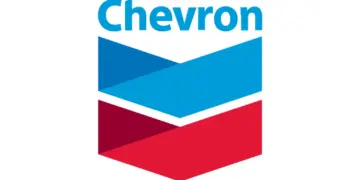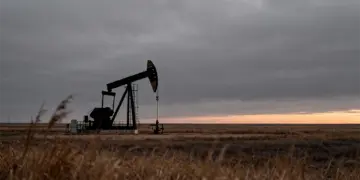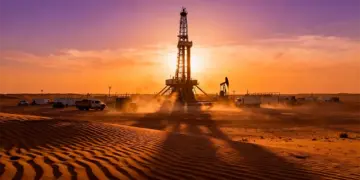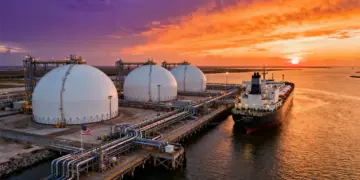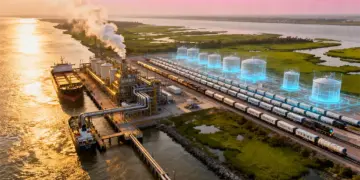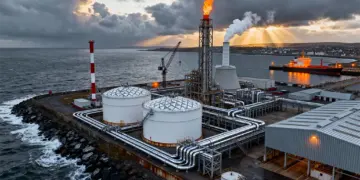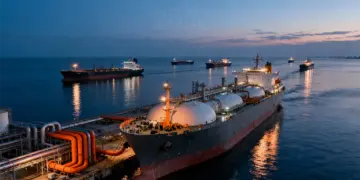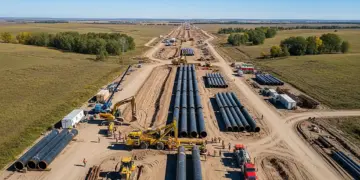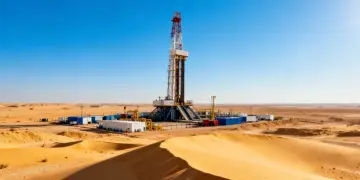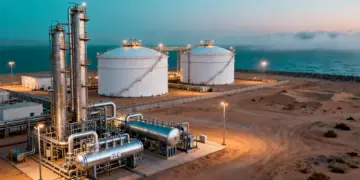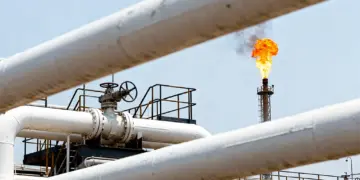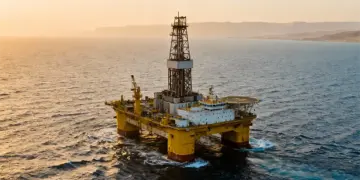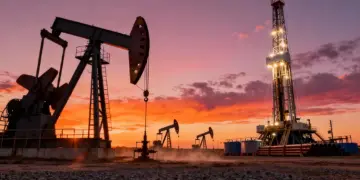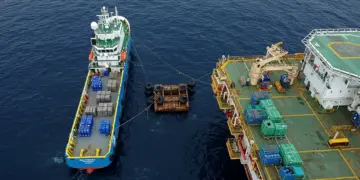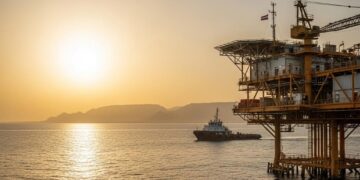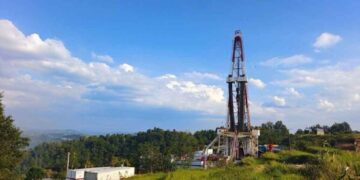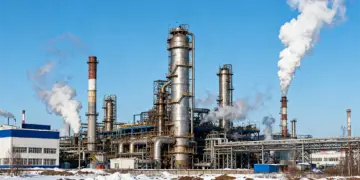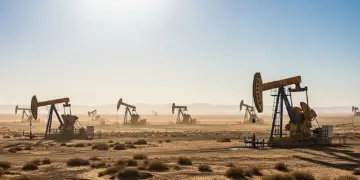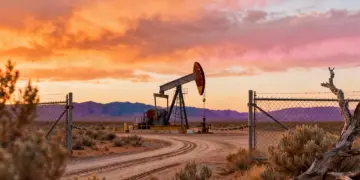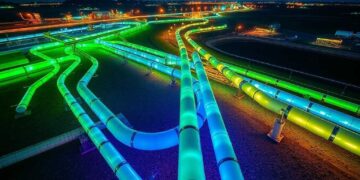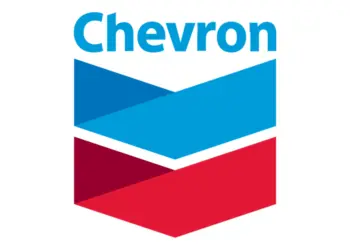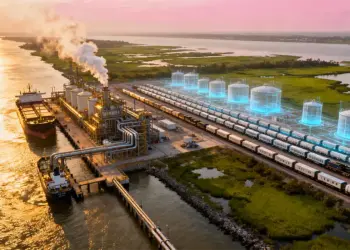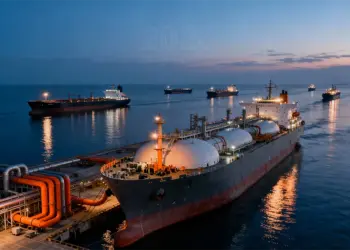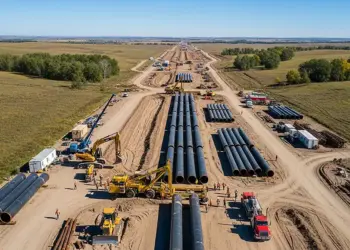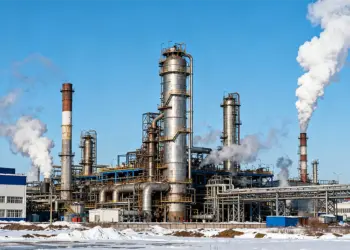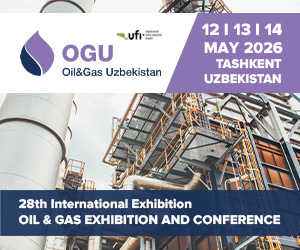The Essar Oil Ltd grass roots refinery in Gujarat, India (started in 1996) was completed and commissioned in 2006 (commissioned in third quarter).
The refinery project was delayed several times due to environmental concerns and financial problems, including initial cost overruns and a shortfall in equity contributions.
According to company reports, the refinery was 60% complete in 1998 but had the misfortune to be struck by a cyclone that caused considerable damage. The refinery currently has the capacity to produce 370,000 barrels a day (13.5 million tonnes per year) and plans are underway to increase the capacity to 680,000 barrels a day (34mtpa) by the end of fiscal 2010. The refinery employs over 1,000 personnel (the construction process required between 3,000 and 4,000).
The refinery is now the second largest in India after the Reliance Jamnagar refinery on an adjacent site which can produce over 27mtpa.
“The Essar Oil grass roots refinery in Gujarat was commissioned in 2006.”
Essar Oil focuses on producing middle distillates such as high-grade kerosene oil and low sulphur high-speed diesel, which form over 60% of India’s domestic consumer demand.
Substituting imports will help conserve India’s foreign exchange. The refinery will also produce LPG and lead-free gasoline of various octane levels for the domestic markets and high-octane lead-free gasoline for export. Essar Oil has 1,300 retail stations with plans to add another 150 outlets by the end of 2010.
Refinery start-up
In November 2006 Essar Oil started operations in its Vadinar grass roots refinery and trial production with a capacity of 7.5mtpa. In December 2006, the plant dispatched its first cargo of 35,000t vacuum gas oil.
Essar shut down the plant for three weeks in July 2007 to upgrade the capacity to 210,000bpd as well as to add secondary units.
After the start of the commercial production of 10.5mtpa in May 2008, in August 2008 Essar Oil reported a gross sale of Rs100bn for the first two months of its commercial operations. The profit for the quarter ending 30 June 2008 was Rs4.34bn.
Essar posted a gross turnover of INR418bn between May 2008 and March 2009. Since then it has increased by 19.7% in the first quarter of 2010.
Commissioning process
The units commissioned in the first phase were the CDU, VDU, sulphur gas unit, naphtha hydrotreater, catalytic cracker and visbreaker. The fluid catalytic cracker and a diesel hydro desulphuriser were commissioned in November 2006.
The FCC and DHDS plants were modified so as to be compliant with the cleaner Euro III and Euro IV fuels. The refinery configuration lends itself well to de-bottlenecking and its capacity is believed can be enhanced to 14mtpa.
“Essar Oil will focus on producing middle distillates.”
The refinery is fully integrated with its own dedicated 77MW power plant, which it plans to expand to 1,200MW plant.
The docking facilities include an SBM capable of handling vessels up to 350,000DWT with a capacity of 25mtpa, tankages with interconnecting pipelines of 20mtpa capacity, marine product dispatch capacity of 12mtpa and rail-car and truck-loading facilities.
In early 2007 a fire was reported at the refinery where four people were killed and 18 injured. The fire broke out when workers were carrying out welding work near a naphtha pipeline (which apparently was leaking). The refinery is now back in production producing in excess of 150,000 barrels a day.
Crude supply
Ahead of the commissioning the company received one million barrels at the Vadinar port in Gujarat in August 2006. The crude was a Saharan blend suitable for refining in the Essar Oil’s refinery. The company also received a second cargo from Vitol in West Asia. Both cargos were of sweet crude.
The annual requirement of crude oil at the refinery is in the region of 10.5mtpa. The refinery is configured to allow flexibility to process diverse varieties and qualities of crude. The refinery is primarily designed to handle a crude mix of Arabian Light and Heavy in a 70:30 ratio. However, adequate flexibility has been provided to handle a variety of crude mixes at refinery processing units from sweet-light crude to heavy high sulphur sour and bituminous crude.
The refinery refines crude oil to produce diesel, gasoline, jet fuel, kerosene, fuel oil and bitumen to suit market requirements. Imported crude oil is discharged from a single buoy mooring situated off a coastal site at a distance of 8km. A submarine / onshore pipeline transfers crude to onshore storage tanks.
Contractors and construction
The principal contractor and project manager for the project since it was started is ABB Lummus Global of the Netherlands (ABB put Rs9,300 into the project). The company responsible for detailed engineering, procurement and construction (EPC) is TCE. Larsen and Toubro is another engineering company involved in the project. Semb Co E&C has secured contracts worth $350m for engineering, procurement, project management and construction management for the project.
The TCE remit for construction includes offsite facilities, storage and transfer of crude, intermediates and products, blending facilities, despatch facilities, fuel oil / gas system, effluent treatment and disposal facilities. Utilities include power / steam generation facilities (two 38.5MW / three 150t per hour) with distribution network, compressed air (three 3,120Nm³ per hour) and nitrogen system (1,900Nm³ per hour), demineralising plant (775m³ per hour), desalination plant (two 390m³ per hour), salt cooling water facilities (64,000m³ per hour) and tempered water facilities.
“The refinery is fully integrated with its own dedicated 120MW power plant, port and terminal facilities.”
A refinery-wide integrated Distributed Control System (DCS), safe guarding system, fire and gas detection system and electrical control system is provided with hardware located in satellite buildings and operator consoles provided in the crude oil tank control building and central control building. A sophisticated Tank Gauging System (TGS) has been provided – one each for crude oil tank farm, product and intermediate tank farm and despatch tankages – comprising radar, servo and hydrostatic systems. Over 700 motor-operated valves with intelligent actuators are connected to DCS and emergency shutdown systems. The despatch automation system is integrated with the TGS and DCS systems.
The refinery is being constructed with a view to the future since it will have sufficient infrastructure for a low-cost expansion to a production capacity of 27mmtpa. The refinery also has two desalination plants each with a capacity to produce 8,450m³ a day of less-than-5ppm total dissolved solids (TDS) from feed water of 40,000ppm TDS (sea water).
Port and shipping
The refinery has its own port and terminal facilities. Vadinar port is an all-weather, deep-draft, natural port with loading facilities for railcars and trucks.
Vessels up to 350,000dwt can be handled through single point mooring (SPM) and there is also a marine product dispatch with a capacity of 14mtpa.
Essar Shipping has an agreement with Essar Oil to ship crude oil as required by the refinery. Essar Oil has set up a new company, Vadinar Oil Terminal, to administer all affairs of the new deep-water port on behalf of Essar Oil and Essar Shipping.
Pipelines
The refinery is ideally located on the west coast of India at Vadinar, Gujarat, close to both suppliers and customers. This is the nearest point to the Middle East, which is a major source of crude supply. The site is linked to the Kandla-Bhatinda product pipeline through the Vadinar-Kandla pipeline, giving it easy access to the key markets of North India.
Essar constructions has bagged several pipeline projects over the past few years. The projects include the INR2bn Baroda – Ahmedabad – Kalol gas pipeline project, a Rs740m product pipeline project in Tamil Nadu, a Rs1.3bn gas pipeline project from GAIL and most recently a Rs1.9bn, 504km pipeline project.
Essar Oil also has a stake in the pipe-holding company Petronet India.
Financing
Funding for the project, which amounts to an estimated INR98,740 ($2.26bn), has been a complicated arrangement.
“The proposed Central India pipeline will transport its products to parts of western and central India.”
Financial closure by Essar Oil has now been achieved for the project. In January 2005, Essar Projects raised Rs3,750 through Global Depository Receipts (GDR) and Essar Shipping raised $213m through the issuing of Foreign Currency Convertible Bonds (FCCB), to make a total of $299m (this was a condition of the remaining funds being released).
The financial institutions, including ICICI bank, the Industrial Development Bank of India (IDBI) and the Industrial Finance Corporation of India (IFCI) bank, then released the remainder of the RS80,000 funding held in escrow for the project.
In October 2008, Essat Oil ordered four steam turbine generators from Siemens Energy for the Vadinar Oil refinery in Gujarat. The $50m deal includes two steam turbines each rated at 105MW, two 93MW steam turbines and four generators.
Delivery of the steam turbine generators is scheduled by the third quarter of 2010.
Expansion
Essar Oil Refinery will be expanded in two phases to achieve a capacity of 36mmtpa. The first phase comprises capacity expansion to 18mmtpa. An investment of Rs78bn is being made in the first phase, which is scheduled to be commissioned by March 2011. By the end of the first half of 2009 33% of phase I had been completed.
In phase II, there are plans for establishing a new processing unit with a capacity of 18mmtpa. An investment of $4bn is being made in the phase II expansion, which is expected expected to be completed by March 2013.
Essar’s construction arm, Essar Construction (I), is undertaking the expansion of the refinery. As of Janauary 2010, 28% of the construction was completed and overall refinery expansion of 41% was achieved.
On completion Essar oil will produce products in compliance with International environmental norms Euro IV and V.


